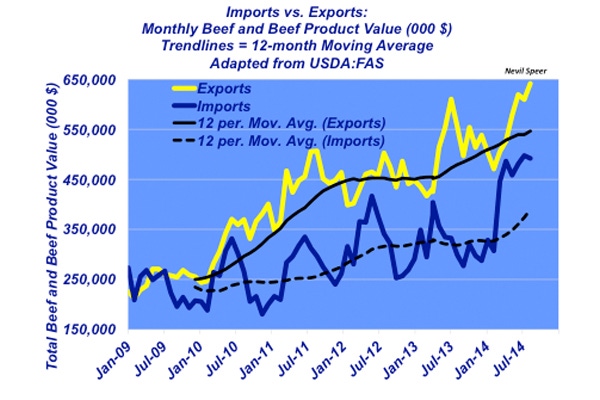Industry At A Glance: Stronger Dollar Isn’t Affecting Beef Exports
U.S. beef set a new record in August with $641 million in exports.
October 23, 2014

The strength of the U.S. dollar has surged in 2014, which has led many multi-national companies to issue warnings about sales and profitability for the next earnings season. A strong dollar makes U.S. products less competitive in foreign markets, and slows down the rate of exports. Simultaneously, though, it also makes foreign goods coming to the U.S. relatively less expensive.
International trade (in both directions) is an important component of the U.S. agricultural industry – including beef. As such, any sharp and/or sudden changes in foreign exchange rates can readily influence trade with other countries. The accompanying graph depicts monthly beef and beef product trade value for both imports and exports since January 2009.

Not surprisingly, imports have risen during the past 12 months. A stronger dollar has underpinned the lean trimmings market as domestic cow and bull slaughter has declined. Indirectly, the stronger dollar may help foster rebuilding the cowherd. That is, a stronger dollar makes imports more advantageous vs. domestic supplies of lean trimmings, and thereby puts a relative lid on slaughter cow/bull prices. Conversely, a weakening dollar encourages domestic sources, boosts slaughter cow/bull prices and encourages producers to bring cull cows and bulls to market.
Surprisingly, though, despite a stronger dollar, beef exports haven’t seemed to slow down. International demand represents an important component to the overall market. August produced a new monthly record at $641 million. Moreover, the 12-month moving average now stands at $550 million.
How do you perceive the influence of the dollar upon the market? Where do you see these markets headed during the next several years? Do you have concerns about global economic growth and the U.S. beef industry’s competitiveness? Leave your thoughts in the comment section below.
You might also like:
Enjoy A Laugh On Us! Rubes Cartoons Updated With New Laughs
65 Photos That Celebrate Cowgirls & Cattlewomen
2015 Land Price Outlook -- What Will Prices Be?
World Beef Supplies Remain Tight
Photo Tour: World's Largest Vertically Integrated Cattle Operation
5 Tips For Getting The Most Cash For Your Cull Cows
About the Author(s)
You May Also Like


.png?width=300&auto=webp&quality=80&disable=upscale)


